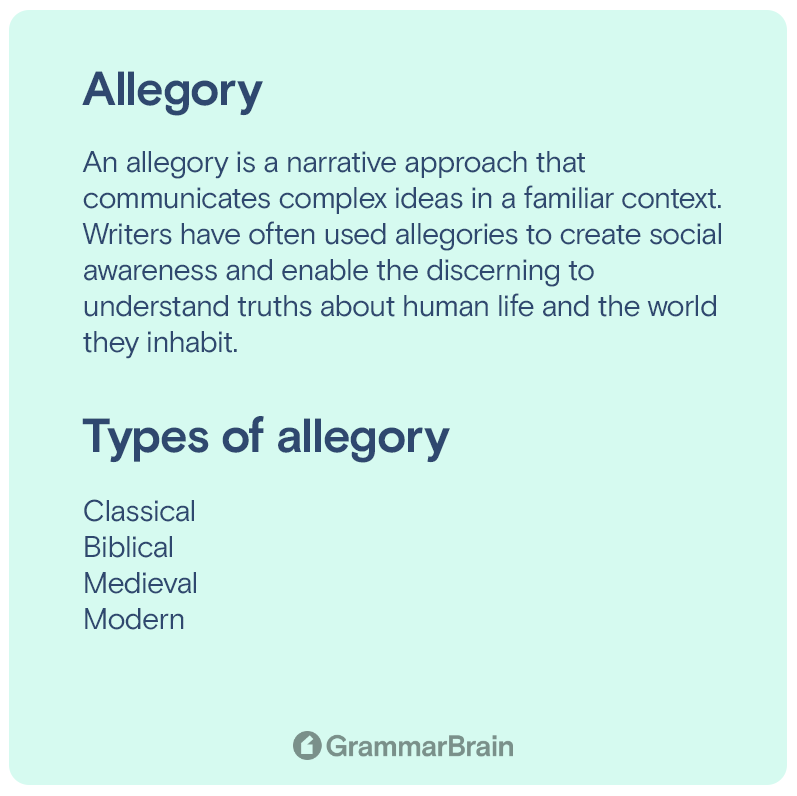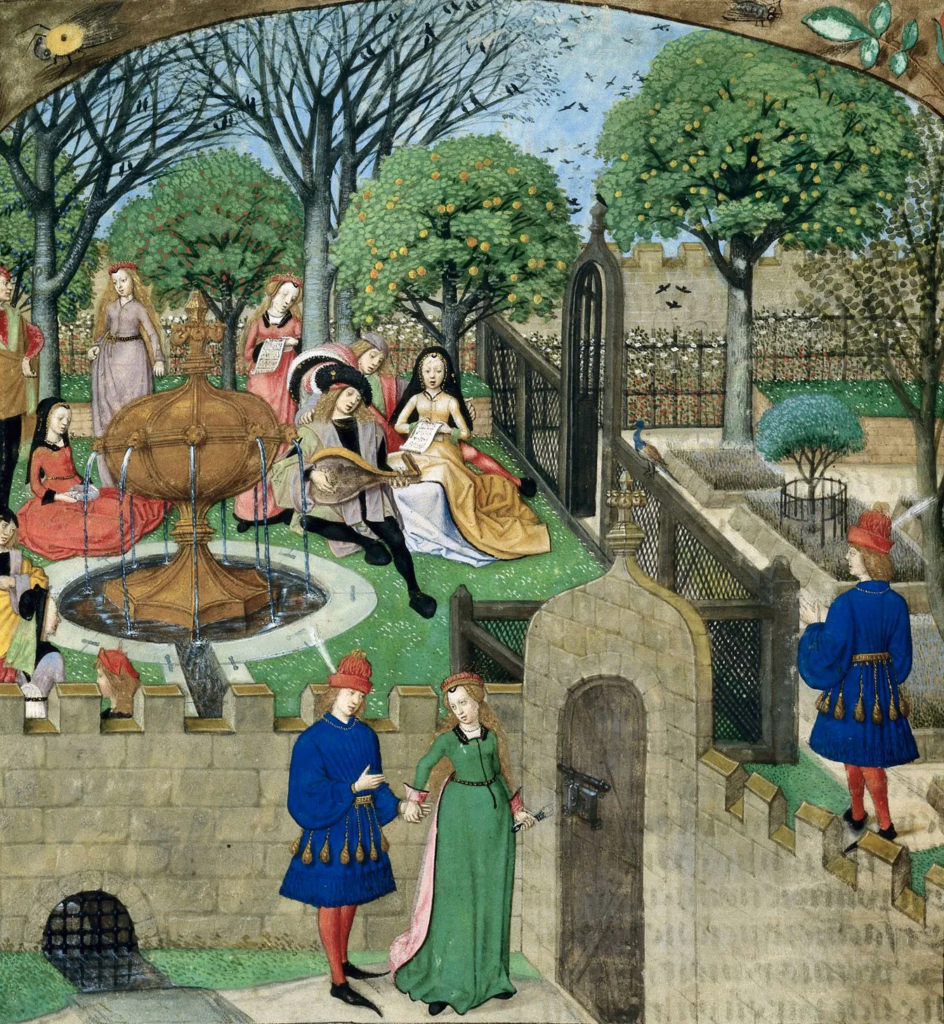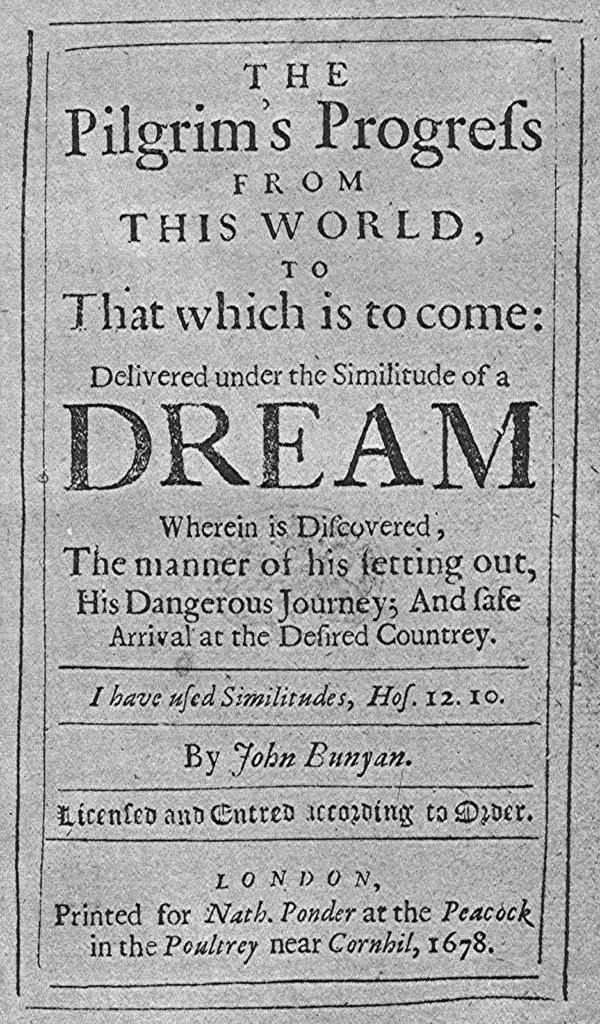What is an allegory? Let’s begin with an example. In a big city lived two powerful families, the Joneses, and the Smiths, in giant mansions. The families were rivals in almost every aspect. The people of each family were suspicious of the other’s intentions and thought they were perennially up to no good.
Each group perceived the other as a threat to its interests, way of life, and existence. So both families spent enormous amounts of money to stockpile opposing tools to serve as a deterrent against potential threats.
At the same time, they also influenced other families to be a part of their social and business circle, forming two major factions in the city. They also undermined their adversary’s reputation and standing in the city whenever possible.
The above narrative is a short allegory for the cold war between the USA and the erstwhile USSR in the post-World War II era.

What is an Allegory?
An allegory is a narrative approach that communicates complex ideas in a familiar context. Writers have often used allegories to create social awareness and enable the discerning to understand truths about human life and the world they inhabit.
| Type | Classical |
| Type | Biblical |
| Type | Medieval |
| Type | Modern |
Definition
An allegory is a literary technique or artistic method that symbolically conveys abstract, hidden, and moral meanings through different genres or works of art.
The literary genres encompass fiction such as short stories, plays, novels or epics, and poetry. Allegories are also expressed artistically through paintings, pictures, murals, and sculptures.
The term “allegory” is derived from the Latin “allegoria” which comes from Greek. It means veiled or figurative words that suggest something different along with its obvious sense.
Watch a short video lesson
The allegorical story has its own plot, setting, and characters and can be read as a standalone tale. However, a deeper analysis reveals the subtle significance of each event, personality, and circumstance.
The writer uses characters and events figuratively to represent concepts or situations related to politics, religion, and spirituality. The allegory expresses something not readily apparent or may be controversial to discuss openly.
| Word | Definition |
| Allegory (noun) /ˈaləˌɡôrē/ | a story, poem, or picture that can be interpreted to reveal a hidden meaning, typically a moral or political one. |
Synonyms
- Fable
- Parable
- Saga
- Apologue
- Emblem
- Metaphor
- Fiction
- Simile
- Illustration
Fable
A fable is a short story in which animals, plants, or inanimate objects are attributed to human qualities.
The stories impart lessons about the importance of leading a moral life. The most familiar example of this genre is Aesop’s Fables.
An allegory is often referred to as a fable though the two genres differ at times. An allegory has a much broader connotation and includes fables as one of its sub-types.
Parable
A parable is similar to a fable but with actual human characters. It, too, serves a didactic purpose and teaches the reader about ethics and values.
Examples of parables include “The Boy who cried Wolf” and “The Good Samaritan.”
Fables and parables are sometimes called naïve allegories as the characters are not fully three-dimensional or realistic and epitomize a moral trait.
Apologue
An apologue or apology is a narrative with dramatic and often exaggerated elements to convince the reader about some lesson about life in general.
The apologue often uses satire and rhetorical arguments to convey the message. The stories about Br’er Rabbit in African American folklore exemplify apologue.
Emblem
An emblem is an allegorical image, often with an inscribed dictum, that symbolizes a quality or stands for the justification of authority.
Antonyms
An allegory is considered a fictional narrative as it primarily uses stories to convey abstract meanings.
This distinction is not concrete, as allegories sometimes incorporate historical events and personalities—this a point for the philologists and literature aficionados to argue.
However, any literature that comes under non-fiction comprising details that you can verify is an antonym of allegory. This includes anything which has taken place and is recorded in some form.
- Fact
- History
- Anecdote
- Record
- Archive
- Chronicle
- Biography or autobiography

Types of Allegory
Allegories are categorized according to the institution that encouraged extensive use of the literary device.
Sometimes the classification is also based on the context in which the technique is used, such as historical or conceptual allegories and personification or symbolic allegories.
The different types of allegories, according to the school of thought, are:
Classical Allegory
The first recorded use of allegories dates from the classical age of ancient Greece and Rome.
The legendary Greek poet Homer is considered the pioneer among the early authors who used allegories in their writings. In the epic poem the Illiad, Homer mentions Phobos as the personification and deity of fear and Deimos of terror.
Other classical poets, such as Plato and the Roman philosopher Cicero, are famous for using allegories. Plato’s Cave in his philosophical work The Republic is a well-known example of allegory.

Allegory of Plato’s Cave
The allegory describes a group of people who are chained in a cave. The people can only view shadows of objects cast on a wall in front of them by a fire behind them. The people take the shadows or whatever they can perceive by their senses to be their reality.
The people do not comprehend the illusionary nature of their world. A person from the group manages to escape from his bonds and can view the truth.
However, the others remain adamant about the veracity of their distorted view after he tries to tell them about the actual state of affairs. The cave and its inhabitants represent the deluded perceptions of human beings and the limits of the senses in grasping reality.
Biblical Allegory
Early Christian theologians such as Origen and Augustine of Hippo frequently interpreted the Bible in allegorical terms. The themes explore the eternal struggle between light and darkness or good and evil
Other allegories include the symbolism of the Vine and its proliferation in the Old Testament, which stands for Israel’s settlement of the Promised Land. The Eagle’s acquisition of the vine represents the Israelites’ exile to Babylon.
The Roman poet Prudentius made extensive use of allegories in his work, Psychomania in which the virtues and vices are personified and engaged in a fight. The forces of good represented as Modesty, Purity, Soberness, and Hope, fight the evil legions comprising Conceit, Anger, Greed, and Faithlessness.
Allegorical interpretation of the Bible has a long tradition stemming from Judaism. The allegorical method is among the four senses of interpreting the Bible.
The first sense includes literal or historical interpretation in terms of records. The second sense is allegorical or typological, which seeks to link the happenings in Christ’s life recounted in the New Testament with the parables in the Old Testament. The third sense is moral or instructive, while the fourth deals with the future in terms of prophecies.
Medieval Allegory
Most allegorical stories in medieval times come from a long tradition of folklore, myths, and legends. Wandering bards and minstrels conveyed the tales in villages and towns throughout Europe.
Aesop’s Fables is a compilation of stories known across different regions and cultures in antiquity.
The allegory was a popular literary device in medieval times. This period is known for the increased use of typology in addressing the apparent incongruities between the Old and New Testaments. For example, the story of Jonah and the whale was interpreted as heralding Christ’s burial and resurrection after three days.
The Italian painter Sano di Pietro’s painting of Christ on the cross depicts a pelican feeding its chicks with blood from a self-inflicted wound. The painting was interpreted as an allegory of Christ’s sacrifice for sustaining the world.
The allegory was a popular literary device in medieval times. This period is known for the increased use of typology in addressing the apparent incongruities between the Old and New Testaments. For example, the story of Jonah and the whale was interpreted as heralding Christ’s burial and resurrection after three days.
Philosophers in this period often saw nature as an allegory of religion. Interpreting animals, trees and inanimate objects in terms of Christian virtues was a common theme. The activities of animals, harvests, and seasons were considered symbols of Divine forces representing cooperation and harmony prevalent in nature.
Allegories lost precedence in literature in the late medieval period with the advent of the scientific temperament among people such as Galileo, heralding the scientific age.
Modern Allegory
Allegories are enjoying a revival in modern times, not only in literature but also in movies.
A writer may choose to convey subtle commentary through an allegorical story such as George Orwell’s Animal Farm or 1984. However, the allegorical meaning need not always be consciously intended on the writer’s part.
Several literary works today are considered as allegories despite the authors denying that they were written as such. So an allegory can be the reader discovering an ulterior meaning according to one’s viewpoint.
A new term, “allegoresis,” describes the reader or viewer interpreting any literature or a movie as an allegory.
Examples of allegoresis include C.S. Lewis’ The Chronicles of Narnia and J.R.R. Tolkien’s The Lord of the Rings. While the former is considered a Biblical allegory, the latter is considered an interpretation of World War I.
Dr. Seuss’ The Sneetches is often considered an allegory for racial discrimination, among other prejudices. William Golding’s Lord of the Flies, too, is rich with allegories covering political and social issues.
Filmmakers currently prefer allegorical themes as an effective way to deal with contemporary concerns.
Some movies with a possible allegorical interpretation for modern times include:
- The Lion King
- Inside Out
- Avatar
- The Truman Show
- Inception
- Metropolis
- Fight Club
- Pan’s Labyrinth
Poetry and Fiction
Allegories have always been a favored literary device of poets. Examples of allegories in poetry abound from classical times to the present.
Medieval poets often used symbolic allegory to convey complex ideas with an emphasis on subjective interpretation according to the reader’s mindset. The French poem Roman de la rose influenced several poets in the middle ages of its technique involving personification and multiple potential meanings.
In Dante’s The Divine Comedy, Virgil’s character has a dual interpretation as the author of the Aeneid and symbolizes the intellect.
Edmund Spenser’s Faerie Queene is among the first allegorical poems in English. The poem noted for the Spenserian stanza also includes a subtle commentary on the political situation during the reign of Queen Elizabeth I. The poem also upholds Christian virtues as a means of attaining salvation from past misdemeanors conveyed through the examples of Arthurian knights.
John Bunyan’s The Pilgrim’s Progress tracks the journey of Christians from his hometown to the Celestial City. The story is a straight allegory symbolizing the soul’s journey as it struggles with worldly temptations, sins, and false prophets along the way.
- L. Frank Baum’s The Wonderful Wizard of Oz is an allegorical novel describing the economic and political events in the U.S. at the beginning of the twentieth century.
- The works of Franz Kafka, such as The Metamorphosis and The Trial, are often cited as examples of allegories in which human beings struggle futilely against forces beyond their comprehension.
- Arthur Miller’s The Crucible is an allegory for the persecution of suspected soviet forces in the U.S.
- Robert Louis Stevenson’s The Strange Case of Dr. Jekyll and Mr. Hyde is an allegory about the tug of war between each individual’s rational aspects and bestial instincts.
Understanding Allegory vs. Metaphor
The difference between an allegory and a metaphor is more of quantity than quantity.
A metaphor is a short figure of speech that describes in a few words a living, inanimate, or abstract entity by referring to something else as a symbol or analogy.
An allegory, on the other hand, is an entire literary piece that may contain several metaphors to convey multiple symbolisms.
An allegory has more scope to convey several ideas with plot, characters, and setting. A metaphor has limited scope and is not necessarily used to impart some lesson, unlike an allegory.
An allegory is created by connecting different metaphors to weave a whole story in which abstract concepts, socio-political issues, and religious parables converge.
Examples
- The sentence, “My friend’s house is a prison for teenagers,” contains a metaphor. The house is compared to prison to indicate the lack of freedom required for teens.
- The fable Animal Farm contains several metaphors, such as the sentence, “No animal escapes the cruel knife in the end.” The fable itself is an allegory symbolizing the totalitarian government in the former USSR.
Understanding Allegory vs. Symbolism
Symbolism means the use of objects or characters to express abstract concepts. An allegory is a narration made up of several symbols to convey subtler meaning to the reader than what’s literal.
While an allegory always contains symbolism, the use of symbols does not always make a work of art an allegory. A writer or artist may include a symbol in a story or picture without allegorical motives.
For example, a red rose symbolizes love in any story or poem.
A typical allegory contains a moral theme or message within the framework of a story. The theme is conveyed through symbols such as the esoteric concepts in religious scriptures or different virtues.
The writer often includes symbols to personify the aspects while deriving the situations from contemporary culture to serve as a vehicle for the ideas.
Examples
- In the Pilgrim’s Progress, the protagonist’s journey is an allegory for the soul’s path to reach heaven or attain salvation. The protagonist, Christian, is a symbol of a devout follower of Jesus Christ.
- In Robert Browning’s poem “My Last Duchess,” the poet uses the symbolism of Neptune taming a sea horse to depict the ruthless character of the Duke of Ferrera. However, the poem is not an allegory despite containing several symbols.
Common Questions
Common questions about allegories.
What is “Animal Farm” an allegory for?
George Orwell’s Animal Farm is the best-known allegorical novel with a political theme. The novel is also a fable as it uses anthropomorphism or animals having human attributes.
The animals on a farm come together to overthrow the despotic owner. The animals then seek to run the farm together as a cooperative effort. However, the pigs in charge of the farm turn out to be even more oppressive, not to mention hypocritical.
On a deeper symbolic level, the story is a political allegory portraying the Russian Revolution. During the revolution, the Bolsheviks took over the government from the Czar. The pigs represent the revolution’s leaders, such as Vladimir Lenin, Joseph Stalin, and Leon Trotsky.
The ideology under which the animals come together in the spirit of collective effort stands for communism. The animals are a symbol of the proletariat or workers.
The novel’s message is not just to show the shortcomings of communism but also that in politics, the more the changes, the more things remain the same or become worse.
What is the allegory in “Young Goodman Brown”?
Nathaniel Hawthorne’s short story Young Goodman Brown is an allegory that focuses on the underbelly of society and the dark side of human nature. In the story, young Goodman Brown leaves Faith, his wife whom he has married recently, to run some errands in the forest.
In the forest, he runs into an evil figure, who deludes him by showing him the “truth” about how the world functions. In this process, Goodman Brown loses his innocence and becomes a cynic. The allegory is about the fall of human beings if faith is forsaken due to some irrational urge.
What is the allegory with Venus and Cupid?
Agnolo Bronzino’s An Allegory of Venus and Cupid is a painting from the Late Renaissance period. The painting depicts several characters, such as Time, Folly, Venus, and Cupid.
The painting illustrates a risqué theme with erotic imagery. The central characters in the painting are Cupid, the god of desire, and Venus, the goddess of love, with several figures in the background.
Scholars are unsure about what the allegory implies. Most interpretations involve the dangers of immoral and licentious behavior. Another interpretation is about the cycle of time and its ravages while the drama of human life plays out in its different phases.
What is the “Allegory of the Planets and Continents” (Rococo)?
The Italian artist Giovanni Battista Tiepolo’s Allegory of the Planets and Continents is a painting done in the Rococo style.
The allegorical painting portrays several Greek and Roman mythology characters with the planets and four continents.
The artist depicts the sun god Apollo embarking on his daily course of the heavens attended by the planets while life on the different continents or corners continues. The allegory shows the centrality of the Sun to all creation and the influence of the heavenly or celestial bodies on life on the earthly plane.
FAQs
How many types of allegory are there?
Biblical allegory, symbolic allegory, modern allegory, personification allegory, and classical allegory. Allegory can be found in all types of classical literature. Allegorical interpretations often are associated with what a character represents. This could be political figures, fictional characters, and more.
What is symbolic representation in allegory?
A great example is how Plato used it. Plato used the cave as a symbolic representation of how humans live in the world, contrasting reality versus our interpretation of it.
What is surface story?
Allegory and surface story play a key part together. As readers, our attention remains on the surface story while a symbolic story plays out beside it. Often, the allegory is part of this (a character or material thing associated with a deeper human understanding).
Sources
- What Is Allegory? Types of Allegory in Writing And 5 Tips on Using Allegory in Writing
- What is an Allegory?
- What Is an Allegory? Definition and Examples
- Definition of allegory
- Allegory: art and literature
- What Is Allegory? Definition and Examples from Literature
- What is an Allegory? Definition and Examples in Literature and Film
- What is the definition of allegory?
- Literary Devices: Allegory
Inside this article
Fact checked:
Content is rigorously reviewed by a team of qualified and experienced fact checkers. Fact checkers review articles for factual accuracy, relevance, and timeliness. Learn more.
Core lessons
Glossary
- Abstract Noun
- Accusative Case
- Anecdote
- Antonym
- Active Sentence
- Adverb
- Adjective
- Allegory
- Alliteration
- Adjective Clause
- Adjective Phrase
- Ampersand
- Anastrophe
- Adverbial Clause
- Appositive Phrase
- Clause
- Compound Adjective
- Complex Sentence
- Compound Words
- Compound Predicate
- Common Noun
- Comparative Adjective
- Comparative and Superlative
- Compound Noun
- Compound Subject
- Compound Sentence
- Copular Verb
- Collective Noun
- Colloquialism
- Conciseness
- Consonance
- Conditional
- Concrete Noun
- Conjunction
- Conjugation
- Conditional Sentence
- Comma Splice
- Correlative Conjunction
- Coordinating Conjunction
- Coordinate Adjective
- Cumulative Adjective
- Dative Case
- Determiner
- Declarative Sentence
- Declarative Statement
- Direct Object Pronoun
- Direct Object
- Diction
- Diphthong
- Dangling Modifier
- Demonstrative Pronoun
- Demonstrative Adjective
- Direct Characterization
- Definite Article
- Doublespeak
- False Dilemma Fallacy
- Future Perfect Progressive
- Future Simple
- Future Perfect Continuous
- Future Perfect
- First Conditional
- Irregular Adjective
- Irregular Verb
- Imperative Sentence
- Indefinite Article
- Intransitive Verb
- Introductory Phrase
- Indefinite Pronoun
- Indirect Characterization
- Interrogative Sentence
- Intensive Pronoun
- Inanimate Object
- Indefinite Tense
- Infinitive Phrase
- Interjection
- Intensifier
- Infinitive
- Indicative Mood
- Participle
- Parallelism
- Prepositional Phrase
- Past Simple Tense
- Past Continuous Tense
- Past Perfect Tense
- Past Progressive Tense
- Present Simple Tense
- Present Perfect Tense
- Personal Pronoun
- Personification
- Persuasive Writing
- Parallel Structure
- Phrasal Verb
- Predicate Adjective
- Predicate Nominative
- Phonetic Language
- Plural Noun
- Punctuation
- Punctuation Marks
- Preposition
- Preposition of Place
- Parts of Speech
- Possessive Adjective
- Possessive Determiner
- Possessive Case
- Possessive Noun
- Proper Adjective
- Proper Noun
- Present Participle
- Prefix
- Predicate



